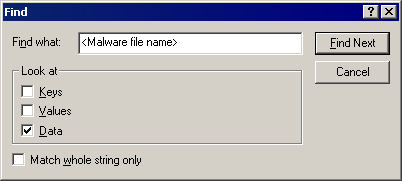BKDR_AFCORE.SMA
Windows 2000, Windows XP, Windows Server 2003


Threat Type: Backdoor
Destructiveness: No
Encrypted: Yes
In the wild: Yes
OVERVIEW
This backdoor arrives as a file that exports the functions of other malware/grayware. It may be dropped by other malware. It arrives as a component bundled with malware/grayware packages.
It may be injected into processes running in memory.
It requires its main component to successfully perform its intended routine.
TECHNICAL DETAILS
Varies
PE
10 Jan 2011
Arrival Details
This backdoor arrives as a file that exports the functions of other malware/grayware.
It may be dropped by other malware.
It arrives as a component bundled with malware/grayware packages.
Installation
This backdoor drops the following non-malicious files:
- %System%\{random characters}.dat
(Note: %System% is the Windows system folder, which is usually C:\Windows\System32.)
It is injected into the following processes running in memory:
- *\explorer.exe
- *\intern*\iexplore.exe
- *\firefox.exe
- *\opera.exe
- *\skype.exe
It may be injected into processes running in memory.
Autostart Technique
This backdoor adds the following registry entries to enable its automatic execution at every system startup:
HKEY_CLASSES_ROOT\CLSID\{random CLSID}
(Default) = 1
HKEY_CLASSES_ROOT\CLSID\{random CLSID}\
InprocServer32
(Default) = {malware path and file name}
HKEY_CLASSES_ROOT\CLSID\{random CLSID}\
InprocServer32
ThreadingModel = Apartment
HKLM\SOFTWARE\Microsoft\
Windows\CurrentVersion\Explorer\
ShellIconOverlayIdentifiers\1
(Default} = {random CLSID}
Other System Modifications
This backdoor adds the following registry keys:
HKEY_CLASSES_ROOT\CLSID\{random CLSID}
HKEY_LOCAL_MACHINE\SOFTWARE\Microsoft\
Windows\CurrentVersion\Explorer\
ShellIconOverlayIdentifiers\1
Other Details
This backdoor requires its main component to successfully perform its intended routine.
It does the following:
- Monitors the browsing activities of the user and log keystroke when the user is accessing sites with the following strings:
- *.nhs.net/*
- *.nhs.uk/*
- *.hilton.*
- *.yahoo.*
- *.google.*
- https://*
- Performs the following actions:
- Create, list, and delete cookies
- Download other files
- Execute programs
- Flood drives
- List, delete, and modify browser cookies
- Manipulate files
- Obtain various system information (i.e., local time, drive information, idle time)
- Perform distributed denial of service (DDoS) attack against a target site
- Resolve host names
- Restart Windows
- Turn off the system
- Sniff packets
- Uninstall itself
- Visit websites
SOLUTION
8.900
Step 1
Before doing any scans, Windows XP, Windows Vista, and Windows 7 users must disable System Restore to allow full scanning of their computers.
Step 2
Scan your computer with your Trend Micro product and note files detected as BKDR_AFCORE.SMA
Step 3
Restart in Safe Mode
Step 4
Delete the random registry key/s that this malware created
Important: Editing the Windows Registry incorrectly can lead to irreversible system malfunction. Please do this only if you know how to or you can seek your system administrator’s help. You may also check out this Microsoft article first before modifying your computer's registry.
Step 5
Delete this registry key
Important: Editing the Windows Registry incorrectly can lead to irreversible system malfunction. Please do this step only if you know how or you can ask assistance from your system administrator. Else, check this Microsoft article first before modifying your computer's registry.
- In HKEY_LOCAL_MACHINE\SOFTWARE\Microsoft\Windows\CurrentVersion\Explorer\ShellIconOverlayIdentifiers
- 1
- 1
Step 6
Search and delete these components
Step 7
Restart in normal mode and scan your computer with your Trend Micro product for files detected as BKDR_AFCORE.SMA. If the detected files have already been cleaned, deleted, or quarantined by your Trend Micro product, no further step is required. You may opt to simply delete the quarantined files. Please check this Knowledge Base page for more information.
Did this description help? Tell us how we did.


